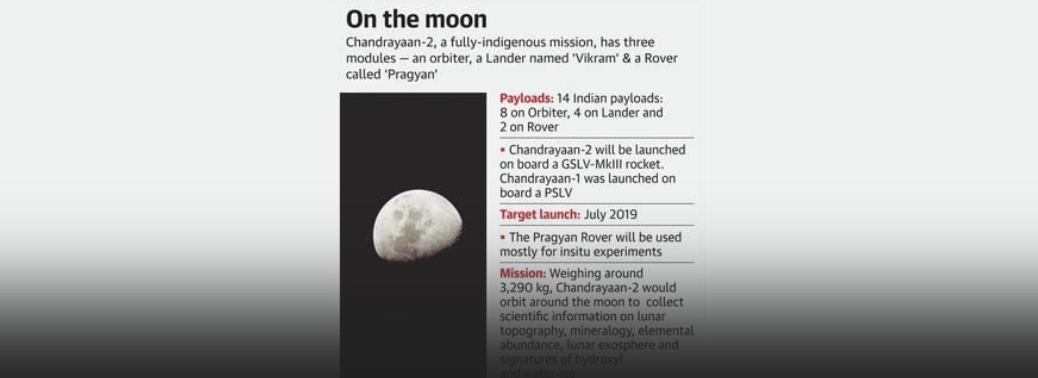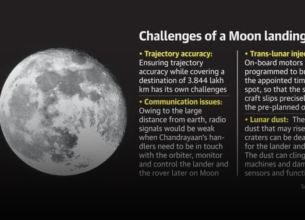Chandrayan -2 to Be Launched in July
11, May 2019

Prelims level : Science and Tech
Mains level : GS-III Technology, Economic development, security and disaster Management
Why in News:
- Chandrayan-2, a fully indigenous mission to be launched during mid of July with 14 Indian payloads
Background:
- In October 2008, the space organisation had launched its orbiter mission Chandrayaan-1 on its PSLV The spacecraft had 11 payloads. One of the U.S. payloads shares credit with Chandrayaan-1 for confirming the presence of water ice on the moon.
- Before that, the Moon Impacter Probe carrying the Indian tricolour image was made to hard-land on the lunar south pole.
About Chandrayan -2:
- Launch vehicle: GSLV Mk III
- Lift off mass (approx.): 3,890 kg
- Launch from: Satish Dhawan Space Centre, Sriharikota, Andhra Pradesh
- Orbiter: It will orbit the moon at a distance of 100 km from the lunar Payloads on the orbiter are: Large Area Soft X-ray Spectrometer, L and S band Synthetic Aperture Radar, Imaging IR Spectrometer, Neutral Mass Spectrometer and Terrain Mapping Camera-2. The structure of the orbiter was manufactured by Hindustan Aeronautics Limited (HAL).
- Lander: The lander has been named Vikram after scientist Vikram The lander will detach from the orbiter, descend to a lunar orbit, before attempting to land on the surface.
- It will make a soft-landing and deploy the rover. It will also perform some scientific activities for about 15 days. Payloads on the lander are: seismometer, thermal probe, Langmuir probe and radio occultation.
- Rover: The 27 kg rover will operate on solar It will move on six wheels and conduct chemical analyses on-site. It will then transmit the data to the orbiter which will send this data back to the earth station. The rover payloads include Laser induced Breakdown Spectroscope (LIBS) and Alpha Particle Induced X-ray Spectroscope (APIXS). Chandrayaan II is India’s second lunar mission after Chandrayaan I.
- The mission includes a lunar orbiter, rover and a The mission is developed by ISRO, India. Initially, the lander was supposed to have been developed by Russia. But, when Russia cited its inability to provide the lander by 2015, India decided to go solo. Now, the mission is entirely Indian. The launch vehicle would be a GSLV (Geosynchronous Satellite Launch Vehicle Mark III).
Way Ahead:
- The mission is attempting to soft-land on the moon’s surface at a latitude of about 70° south, that would be on a high plain in between 2 If successful, this would be the







